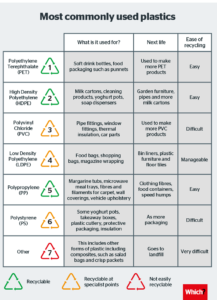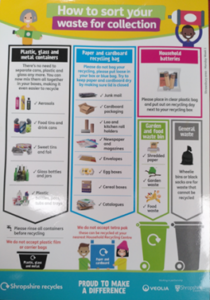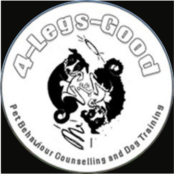Petfood packaging has a quick turnover and almost immediately ends up in the bin. These fast-moving consumer goods, known in the trade as consumer packaged goods (or CPG’s), account for much of a household’s waste.
Cat food pouches are the worst if you ask me – the unrecyclable, eternal, pouch packet is the epitome of the throw away culture. I know cats like their food fresh, they are designed to eat what they have caught, little and often (hence the concept of single fresh meals), but come on! Must every cat have every meal out of an individual eternal pouch packet?
We try to minimise packaging waste when feeding our dogs:
- We have only just started feeding raw. Until recently, feeding raw seemed to involve getting it delivered in a lot of plastic, lots of freezer space and the corresponding electricity – so we didn’t do it.
- We fed wet food in tins as the metal can be recycled via a circular* recycling route.
- In the time we were feeding tinned meat, tins pretty much became unavailable in petshops, with non-recyclable plastic tubs and pouches being the ‘go to’ for pet food manufacturers. I had to order tins to be delivered.
- We now feed ‘paleoridge’ raw food (https://paleoridge.co.uk/about-us) with its biodegradable paper packaging which we compost. Although it’s not locally produced, we buy from a local small business. I can cycle there or pick it up when taking Spot to hydrotherapy. We don’t need to collect much at any one time, thereby saving on freezer space and electricity. We also feed ‘mixer’ biscuits in fully recyclable ‘mono PE’ packaging (see later).
*A circular economy is about maintaining the value of products and packaging after they have been used once, by repairing, re-purposing and recycling as much as possible to ensure material waste is minimised. The goal of a circular economy is for all materials to undergo multiple rounds of re-use and recycling. In this model, materials are not considered waste, but rather are a valuable resource to be capitalised.
We and the petfood industry need to cut down on packaging and swap to eco-friendly alternatives –
Now!
To be fair to petfood manufacturers, pet food packaging has to be food grade. Food-grade packaging has to conform to strict health and safety guidelines making it harder to swap to more sustainable packaging than non-food products. However, things are changing and the pandemic driven explosion of eCommerce has shaken up the industry. For one, pet owners no longer need to carry heavy bags, making bigger, resealable bags possible. Larger, resealable packages represent convenience and affordability for pet owners. It is also better for the planet as bulk buying reduces packaging. This packaging needs to be strong to withstand shipping and delivery.
At the same time, there is a move against paper packaging. Despite its eco- image, paper packaging isn’t ‘circular’. New wood fibres need adding in at every recycling, meaning food-grade paper packaging uses large amounts of paper (and land). Paper production and recycling uses (much) more energy and water and produces more co2 than plastic production. Additionally, food-grade paper packaging requires a plastic coating on the inside to guarantee the shelf life of the product. This plastic coating makes recycling more difficult and reduces the number of cycles. By the way, because what the ‘Paleoridge’ cardboard mentioned earlier houses is frozen, it doesn’t need additional plastic.
Certain plastics do fulfil both the stringent practical and hygienic needs for pet food, are fully recyclable and can be described as circular – provided the recycling facilities are available. There is a new recognition that plastics are valuable and we need to treasure them rather than putting them in the sea!
Example companies:
Yarrah (https://www.yarrah.com), who I feature in the sustainable petfood article, have opted for mono PE packaging. Mono-PE is a high-performance protective packaging for food and drinks. It consists of a single material, polyethylene (or polythene) which is already compatible with existing recycling streams making it easier (and more efficient) for recycling plants to process.
However, in the UK recycling mono PE is described as ‘manageable’ on the ‘which’ recycling chart. (LDPE or 4 on the which chart below). Yarrah are based in the netherlands where recycling is probably more advanced. I have to take the packaging to the coop and squeeze it into their ridiculously small plastic box.
Burns (also featured in the sustainable pet food article), have also moved away from paper packaging to plastic (https://burnspet.co.uk/recyclablepackaging) . Burns are also aiming for a sustainable circular economy. Rather than Mono PE they have opted for polypropylene (PP or 5 on the ‘which’ chart below). This is easier to recycle than the mono PE in the UK, albeit not in every county. PP can be recycled as park benches, bollards and waste bins. I’d say to Burns, that this isn’t circular, rather it is ‘downcycling’ as it requires virgin plastic to make more Burns bags. According to the Big Plastic count, still 30% of what we are using is virgin plastic.
I had a look at my local council website and recycling centre and was surprised to find that they didn’t seem to bother to use the internationally recognised plastics recycling symbols with the corresponding numbers that are printed (or indented) on the plastic I’m trying to recycle – see ‘which’ chart.

Frankly, this seems nuts as surely it would make it much easier for the public to recycle if the symbol on the plastic was matched at the recycling centre! I asked the council to explain, and this is what they said “The plastics we collect from the kerbside are generally identified by the description ‘pots, tubs and trays’ which are common packaging polymers. At the moment, we do not specify by symbol or number which types of plastic are taken in the kerbside collection”. I followed this up further only to receive this flippant reply, “As mentioned, we do not specify by plastic polymer. If you are unsure if something can be recycled, please place it in the refuse bin where it will be turned into electricity instead. None of your waste is wasted in Shropshire”. As an aside, my partner Tim, is a renewable energy expert and he’s not convinced of the efficiency of the incinerator’s generating capacity either!

They went on to say that Shropshire couldn’t recycle my Burns bags despite them being made of the same stuff as some of their ‘pots, tubs and trays’. Meanwhile, Emily, who works for Burns and just happens to live in Shropshire took a collection of Burns bags which she had accumulated to Whitchurch (rather than Shrewsbury) recycling centre and there wasn’t any objection to her putting it into the plastic recycling. Make up your mind Shropshire Council!
No wonder people are confused! According to the recent (July 2022) ‘big plastic count’ only 12% of the plastics that people take the trouble to wash and sort gets recycled – again no wonder. The big plastic count found we use 100 billion bits of plastic a year in the UK, of which the Government says 44% is recycled. However, they count plastic that is collected, exported or made into park benches, whereas big plastic count only counted plastic that is recycled via a circular system. Daniel Web, architect of the big plastic count when interviewed on BBC Radio 4’s consumer program ‘you and yours’, explained that it’s cheaper to use virgin plastic rather than recycled plastic. He went on to say that kerb side collection of domestic recycling is the ‘holy grail’ If ‘consumers’ have to take to it to the recycling centre, they tend not to and recycling doesn’t really work.
New brands need to be born sustainable
Of course, rather than creating products that may or may not be recycled, sustainability needs to be built in from the start. Each piece of pet food packaging needs to be manufactured from materials that are ethical and sustainably sourced and it’s important to separate the different materials, so that they can be easily disposed of in the right way. These days, people are becoming wise to the greenwashing phenomenon and can distinguish between brands that use sustainability as a marketing tool and those that uphold it as a core value.
Obviously, each material used should then be recycled, recovered, or biodegradable where possible. Change drives innovation and there are more new, recycled and recyclable materials on the market, including bottles that are fully recyclable and Pulpex, made out of waste paper a new, eco-friendly packaging technology.
Thankfully, we no longer send to China and Philippines, clearly we should never have done so in the first place, all along Government should have ensured that Councils had support to put the infrastructure in place for a standardised, nationwide recycling systems (using the bloody internationally recognised labelling system!) whilst also putting pressure on manufacturers to reduce packaging and to use packaging that’s relatively easy to recycle. It’s now beyond urgent that the UK Government assist local Councils to improve their handling of all recyclable products and develop recycling centres throughout the UK. Plastic taxes have been introduced into the UK amounting to £2 billion over the last 10 years. The income is supposed to be reinvested into recycling schemes – perhaps this is a beginning…?
Quick footnote on cats – I know it’s a long shot, but if breeders fed weaning kittens a wider variety of foods during the sensitive period for socialisation (2-7 weeks) They’d be more likely to eat a wider variety of foods rather than opting for what they were fed as a kitten in an eternal pouch pocket!
https://wrap.org.uk/resources/guide/recycling-guidelines
https://www.which.co.uk/reviews/shopping-sustainably/article/how-to-recycle-in-the-uk-ajwEz4p63Qs6
(https://xtalks.com/flexible-food-packaging-five-reasons-to-choose-mono-pe-based-laminates-2573/)
‘you and yours’ on bbc radio 4 discussed the ‘big plastic count’ 12th July 2022
